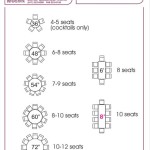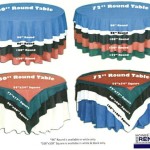What Is The Top Table Seating Plan?
The top table seating plan refers to the strategic arrangement of individuals at the head table during formal events, particularly weddings, corporate gatherings, and galas. Its importance lies in its ability to honor key individuals, promote positive relationships, and contribute to the overall success and enjoyment of the event. A well-thought-out seating plan respects family dynamics, professional hierarchies, and personal connections, while a poorly executed plan can lead to awkwardness, offense, and detract from the intended atmosphere. The process requires careful consideration of various factors, including relationships, status, and guest personalities.
The goal of any top table seating arrangement is to create a harmonious and celebratory environment. This involves minimizing potential conflicts, seating individuals who are likely to engage in positive conversation, and ensuring that the most honored guests are positioned appropriately. The arrangement is not merely about filling seats; it's about creating a visual representation of the relationships and hierarchies that are being celebrated and acknowledged at the event.
The specific details of a top table seating plan will vary significantly depending on the nature of the event, the cultural context, and the preferences of the hosts. However, some general principles and best practices can be applied across a wide range of situations. The planning process is crucial, often starting weeks or even months in advance to allow ample time for adjustments and consultations with relevant parties.
Understanding the Traditional Top Table Layout
The traditional layout for a wedding top table typically includes the bride and groom in the center, symbolizing their union and importance. To the bride's right is traditionally the groom's mother, followed by his father. To the groom's left sits the bride's father, followed by her mother. This arrangement places the parents closest to their respective children, acknowledging their significant role in the couple's lives and the celebration. The best man is usually seated to the right of the groom's father, and the maid of honor is seated to the left of the bride’s mother.
However, modern weddings frequently deviate from this traditional structure. Divorced parents, blended families, and same-sex couples often require alternative seating arrangements that reflect their unique family dynamics. In these situations, the most important consideration is ensuring that all guests feel comfortable and respected. Open communication with family members is crucial to avoid misunderstandings and potential offense.
In corporate settings, the top table layout generally reflects the hierarchical structure of the organization. The CEO or highest-ranking executive typically occupies the central position, flanked by other key leaders and honored guests. The specific arrangement will depend on the nature of the event, the seniority of the attendees, and the desired message that the organizers wish to convey. For instance, during an awards ceremony, award recipients may be seated at the top table to acknowledge their achievements.
Regardless of the specific context, the principle remains the same: the top table seating plan should reflect the importance of the individuals being honored and contribute to a positive and respectful atmosphere. Deviation from traditional structures is often necessary to accommodate modern family dynamics and organizational structures, but it should always be done with careful consideration and sensitivity.
Factors to Consider When Creating a Top Table Seating Plan
Several critical factors should be considered when developing a top table seating plan. These factors include relationships between guests, family dynamics, professional hierarchies, cultural considerations, and personal preferences. A thorough understanding of these factors is essential for creating a seating arrangement that is both functional and respectful.
Relationship dynamics are paramount. Seating individuals who are known to have conflicts or strained relationships next to each other should be avoided whenever possible. Conversely, seating individuals who are likely to enjoy each other's company can contribute to a more positive and engaging atmosphere. This requires a careful assessment of the relationships between all potential guests at the top table.
Family dynamics can be particularly complex, especially in the context of weddings and other family celebrations. Divorced parents, stepparents, and blended families often require special consideration. Open communication with all relevant parties is essential to understand their preferences and sensitivities. The goal is to create a seating arrangement that minimizes potential conflict and ensures that everyone feels comfortable and respected.
Professional hierarchies are a key consideration in corporate settings. The seating arrangement should reflect the organizational structure and acknowledge the seniority of the attendees. This is particularly important during formal events, such as galas and awards ceremonies. However, personal relationships and potential for positive conversation should also be taken into account.
Cultural considerations can also play a significant role. Different cultures may have different traditions and expectations regarding seating arrangements. It is important to be aware of these cultural nuances and to adapt the seating plan accordingly. Consulting with individuals who are familiar with the relevant cultural norms can be helpful in avoiding potential cultural faux pas.
Finally, personal preferences should also be taken into account whenever possible. While it may not be possible to accommodate everyone's preferences, it is important to be sensitive to individual needs and desires. For example, some individuals may prefer to sit next to certain people, while others may have specific dietary requirements or accessibility needs. These preferences should be considered when developing the final seating plan.
Practical Steps for Implementing the Seating Plan
Once the factors have been considered and a draft seating plan has been created, several practical steps are necessary to implement the plan effectively. These steps include confirming attendance, communicating the seating plan to guests, providing clear signage at the event, and being prepared to make adjustments as needed.
Confirming attendance is essential for ensuring that the seating plan accurately reflects the actual number of guests who will be attending the event. This is particularly important in cases where there are late cancellations or unexpected additions to the guest list. Regular communication with guests and prompt follow-up on RSVPs can help to ensure that the seating plan remains accurate.
Communicating the seating plan to guests in advance can help to alleviate any potential anxiety or confusion. This can be done through formal invitations, seating charts displayed at the event, or personal communication with each guest. The level of detail provided will depend on the nature of the event and the preferences of the hosts.
Providing clear signage at the event is crucial for ensuring that guests can easily find their assigned seats. This signage should be visible and easy to read, and it should be placed in strategic locations throughout the venue. Escort cards, table numbers, and seating charts can all be used to help guests find their way to their designated seats.
Being prepared to make adjustments as needed is an important part of the implementation process. Even with careful planning, unexpected issues can arise. For example, a guest may have to cancel at the last minute, or there may be unforeseen seating conflicts. It is important to be flexible and to have a backup plan in place to address these types of situations. Having a designated point person who can handle seating issues on the day of the event can be helpful.
Finally, it's crucial to remember that the seating plan is ultimately a tool to enhance the event experience. While careful planning and attention to detail are important, the primary goal is to create a welcoming and enjoyable atmosphere for all guests. Flexibility, empathy, and a willingness to adapt to changing circumstances are essential for successfully implementing the seating plan and ensuring that the event is a success.
The top table seating plan, therefore, is not merely a logistical exercise. It is a strategic tool that can be used to promote positive relationships, honor key individuals, and contribute to the overall success of the event. By carefully considering the factors outlined above and following the practical steps for implementation, hosts can create a seating arrangement that enhances the event experience for all attendees.

The Wedding Top Table Layout

Wedding Top Table Seating Arrangements Aby Joanne Photography

Arranging Your Wedding Seating Plan And Top Table

Wedding Top Table Diffe Arrangements

Wedding Top Table Layout Guide The Brewery

Best Laid Plans Seating Made Easy Little White Books

Wedding Top Table Seating Arrangements Aby Joanne Photography

Wedding Etiquette Who Sits At The Bridal Table

Take Your Seat Wedding Journal

Our Top 30 Tips For Arranging Your Seating Plan
Related Posts








